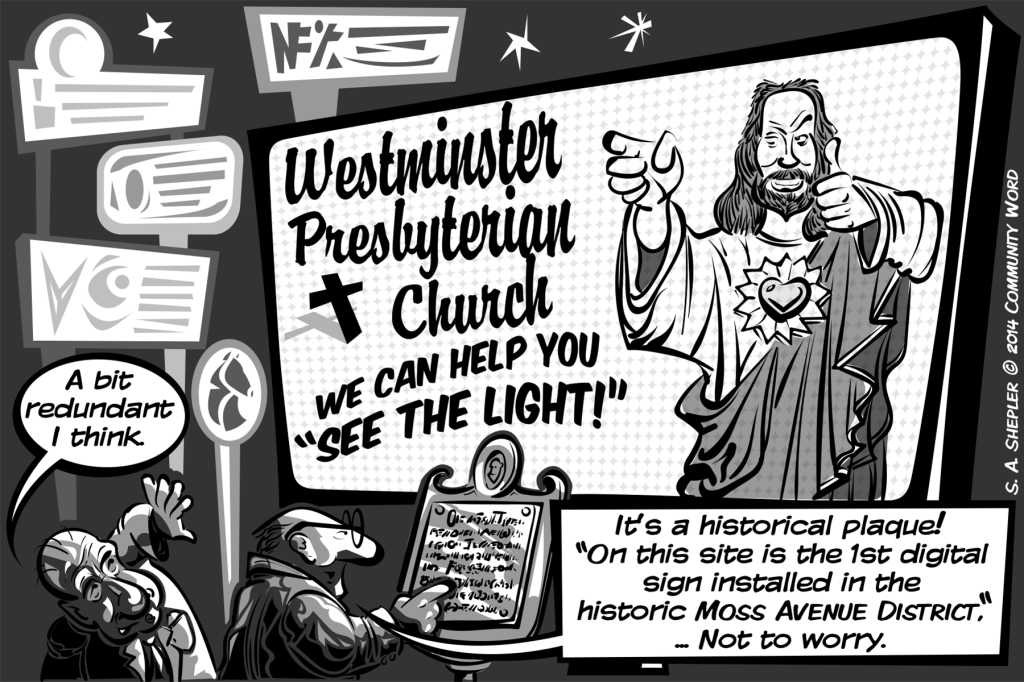The short answer is yes. The long answer involves violation of trust.
Frank Abdnour secured city approval and installed an electronic sign for his restaurant, The Spotted Cow, 718 W. Glen Ave. The sign is up, running and looks fine. The location is in a busy retail area.
When asked about an electronic sign proposed by Westminster Presbyterian Church on Moss Avenue, Abdnour said: “That would be a tragedy. The (digital electronic) signs should not be allowed in residential areas. I’m pro-business, but in residential areas that’s not appropriate.”
Digital signs are considered a “face change” by the city of Peoria and are permitted in locations where signs already exist or would otherwise be permitted, according to Ross Black, director of planning and zoning. However, because Moss is in a historic district, the proposed sign does not go directly to Peoria City Council for approval. It goes to the Peoria Historic Preservation Commission that has been weakened in recent years. The next commission meeting is slated for Jan. 28, and the outcome of the sign vote is uncertain.
Black said if the commission denies the electronic sign, the church can appeal to the city and the issue will go to city council.
After multiple meetings and a modified request by the church, the Moss-Bradley Residential Association stands in opposition to the sign. Westminster’s Rev. Denise Clark-Jones said that decision may reflect only a small portion of the residents in the area, and she said modifications have been made to the proposed sign to make it more acceptable.
Marjorie Klise, a life-long Moss Avenue resident, fears the sign could be precedent setting and is concerned a new owner of the former adult education center down the street could use the church sign to justify a request for a digital sign.
However, above and beyond whatever is bureaucratically legal, Moss Avenue comes with special considerations.
Moss Avenue is a quality of life factor in Peoria. It’s a core, urban neighborhood. Homeowners in this historic district have invested significant personal resources into preservation of their homes. They’ve committed themselves and their families to the vitality and beauty of this neighborhood. New houses in the suburbs are much less expensive to maintain than the Victorian, Georgian and Tudor homes that line this street and tell the history of this community. This is private investment for public good.
Moss Avenue homeowners undertake this commitment based on belief the integrity of the district will be maintained. This is a covenant, an irrevocable trust.
Asked if the church would proceed with the sign if given approval despite the neighborhood association’s objection, Clark-Jones said “our first priority is to be a good neighbor” and “we are committed to a tasteful sign” without colored, strobe lights.
The church’s commitment to the neighborhood has to trump the sign. This is a case where retreat is nobler than victory. The church should withdraw the signage request and prioritize efforts to mend relations with residents. If it doesn’t, the Historical Preservation Commission should reject the request and work to strengthen protection of historic neighborhoods. This is an un-negotiable covenant between homeowners and the Historic Preservation Commission. Clare Howard


1 comment for “Digital sign: Allowed in historic, residential district?”
Recent Comments
As both a member of Westminster and a West Bluff resident, I totally agree with the editorial. The Church would fulfill a decades-long stated commitment to the area by withdrawing the request. I’d also encourage Rev. Clark-Jones to continue interfacing with local residents top learn more about the long history of Westminster Church in the West Bluff.